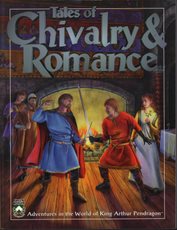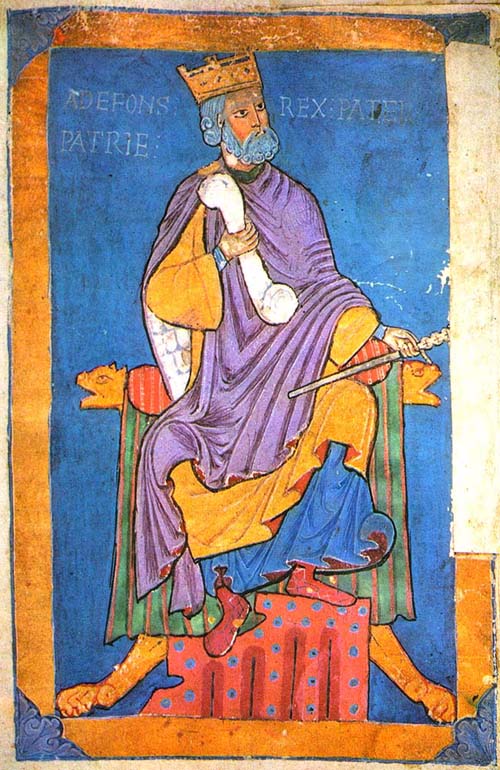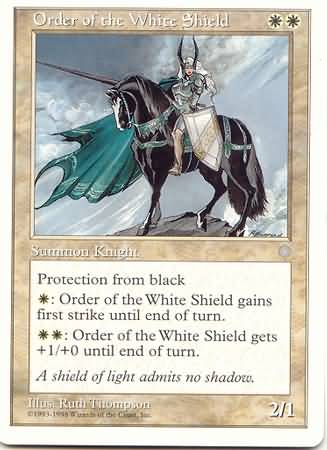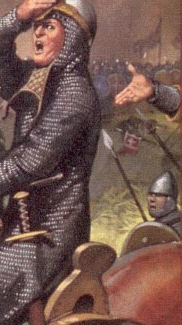Dragon
125:
Chivalry

Dragon
125:
Chivalry

| CHIVALRY: | Orders of Knighthood | Feudal Lords | L&L: 3 Lords from the Age of Chivalry | Taxes, politics, immigrants, and the military | Cavaliers and their pursuit of honor |
| Ecology: Greenhag | Trees of the FR | BB: Magical maps of GH | Positive Quasi-Elementals | Woodlands of the Realms | Dragon |

I14
The Code
of Chivalry
Orders of knighthood in
the AD&D® game

by Mark Easterday
| Organization of an order | Rules of an order | Benefits of an order | The Order of the Star | Bibliography |
| - | - | Dragon 125 | - | - |
The world of the AD&D®
game symbolizes
the eternal struggle of good against
evil. However, players of lawful-good
characters often find themselves at a
great
disadvantage as the evil characters have
far greater powers at their disposal ?
poisons, thieves? and assassins? guilds,
demons and devils, etc. To offset this
imbalance while offering players of lawfulgood
characters more opportunities for
role-playing, this article presents a
set of
rules outlining chivalry, honor, and orders
of knights in the AD&D
game world. This
material supplements the information on
the feudal code
given for cavaliers in
UA, though it is more
restrictive in certain ways, particularly
in
allowable alignments for knighthood.
The code of chivalry is the heart and
soul of the knight. It is the heroic player
character who -- with justice, valor,
loyalty,
modesty, courtesy to equals, compassion
to weakness, and devotion to law and
good -- becomes the champion of the
oppressed and the defender of all that?s
good. Those who follow the code of chivalry
pledge to fight against powerful
dragons, evil enchanters, and wicked
beings of all sorts until they are overthrown
and rendered powerless.
There is no greater honor among lawfulgood
knights than the conquest of evil.
Honor implies renown, good conduct, and
the pursuit of justice. A knight?s word
of
honor is the most solemn oath known;
once a knight gives his word on something,
he may never go back on it. The
respect, glory, and admiration given a
knight depend upon his level of honor.
Chivalry and honor are both incorporated
in the various orders of knights.
Training, leadership, protection, a base
of
operations, and a code of values are benefits
and advantages of joining an order.
The following description of an order
of
knights applies to all orders created
with
these guidelines.
Organization
of an order
The organization of an established order
of knights usually consists of the following:
a Master (at least 13th level of ability),
a Seneschal (the Master?s deputy, at least
9th level),
a Marshal (responsible for direction
of military affairs, at least 9th level),
a
group of High Officers (responsible for
the
order?s castles and troops, at least 9th
level
each), and a main body of knights (4th
level and up). Fighters, rangers, cavaliers,
and paladins may join an order of knights;
barbarians and nonfighter classes cannot.
Clerics may optionally be allowed to join
particularly religious orders of knights
as
full members.
Many NPC knights of an order can be considered
to be average knights of renown, and
knights holding positions of authority
are usually considered to be
knights of quality.
Statistics for both types of knights are
on page 17 of DDG.
An order usually has one castle under its
control for every 10-50 knights in the
order. Every order must have at least
one
castle. The castles have the basic staff
required and a garrison of five zero-level
soldiers per knight assigned to the castle.
Aid and protection for all characters
of
good alignments can be gained at an
order's castle. An order will fight to
defend the lands and towns near the castle
if the populace is of good alignment.
An
attack against one castle belonging to
an
order of knights is regarded as an attack
against them all, although personal duels
and quarrels among knights need not be
avenged by others unless perpetrated by
evil forces.
To join an order of knights, a character
must be a lawful-good fighter, ranger,
cavalier, or paladin of 4th level or greater.
The character must also challenge and
defeat a knight of the order (of equal
level)
in a joust. [Detail on the conduct of
a joust
are given in “Surely,
You Joust!” on pages
22-29, DRAGON® issue #118.]
Rules of an order
The rules of an order of knights may
vary in specifics, but the most basic
rules
are given below. Others may be added as
desired, such as those from UA.16
or from other articles
in this section on chivalry.
1. Knights of the order must have a
heavy war horse, a lance, a sword (except
short swords), a secondary melee weapon,
any armor (except those forbidden to
cavaliers), a shield, and a helmet.
2. Knights of the order cannot use magic
or magical items of an evil nature or
origin.
3. Knights of the order cannot gamble
and must pay a tithe of 10% of their total
income to the order once per month.
4. Knights of the order cannot overindulge
when drinking or eating.
5. Knights of the order must bear the
coat of arms and colors of the order on
their shield, tunic, and clothes.
6. Knights of the order must adhere
strictly to the laws and codes of chivalry,
honor, and lawful-good alignment.
7. If a knight of the order is challenged
by one who wishes to enter the order,
he
must accept the challenge or suffer a
loss
of honor.
8. Knights of the order respect, defend,
and aid all who are weaker than they,
and
show proper regard for the opposite sex.
9. Knights of the order may not bear
arms against each other except in situations
that the law permits (challenges,
games and tournaments, etc.).
10. Chapters of the order (meetings)
must assemble three or four times per
year, and all knights must attend.
11. Knights of the order may challenge
other knights of the order for positions
of
authority (such as High Office) if they
are
of equal or greater level to the one challenged.
The challenge is resolved in a
series of jousts until one knight is
unhorsed. Combat continues on foot until
one knight is defeated.
12. Knights of the order may joust
against other knights of the order during
tournaments held during chapters of the
order.
13. Knights must grant mercy to any
opponent who yields (surrenders). The
defeated opponent must then take an oath
never to bear arms against the knight
who
defeated him again. This applies to warfare
as well as tournament fights.
14. Knights of the order may marry only
persons of good alignment.
15. Knights of the order may participate
in adventures with other characters of
good or neutral alignment. The adventures
must not be evil in nature or goals.
16. Knights of the order may never go
back on or break an oath or word of honor.
17. Knights of the order may choose to
serve in a castle of the order, or they
may
adventure to further the goals of the
order and lawful-good alignment.
18. Knights of the order must take a
solemn oath to uphold the laws of the
order.
Benefits of an
order
Knights of an order receive several
benefits for faithful service. For every
three years a knight spends in the order,
he gains one point of charisma
(to a maximum
of + 2 points). A knight in the order
may have a + 10% XP bonus
when on a quest or mission for the order;
private adventures by the character do
not allow an experience bonus. The order
also pays for all of the knight?s food,
normal
equipment, and weapons, and purchases
a war horse for him if his is slain. A
knight is also assigned 1-4 squires (fighteror
cavalier-types of 0-3rd level) and 1-10
men-at-arms (all zero level) who travel
with him even on private adventures and
are paid for by the order. These retainers
gain half the experience points of the
knight (except men-at-arms who may not
advance in level). Knights of the order
are
not allowed to build or own castles when
they join the order, but are given free
food
and lodging for themselves, their assigned
hirelings, and their good-aligned friends.
Training for level advancement is provid
provided
"free" within an order for lower-level
knights and their retainers -- so long
as all
tithes are promptly paid and a suitable
teacher is available at the time. The
tithe
presented by characters who are wealthy
from adventuring is usually sufficient
to
cover the needs of those characters and
the needs of poorer knights and retainers
as well.
Table 1 shows ways in
which honor
points may be earned, and Table 2 gives
some of the benefits of high honor scores.
The system of honor acquisition given
in
Table 1 is similar to
the one found in OA, and it may be further
expanded using the honor
system on page
36 of that tome. A knight has a starting
honor level of 20. If a knight's honor
ever
drops below zero, he immediately loses
all
benefits acquired from the order and is
expelled from the order permanently. He
also loses one level of experience due
to
disgrace and dishonor, and may be subject
to an alignment change.
The knight's starting honor is, of course,
gained when he is accepted into the order
and knighted. The character also gets
the
honor of having "Sir" before his name.
If a
character fails in a challenge to gain
admittance
to an order, he must wait one month
before trying again, though he cannot
challenge any knight who defeated him
in
combat.
Tournaments are held at every chapter
of an order. All who wish may participate.
There are two main areas of combat for
knights: jousting with lance and shield
is
the first, and a bloody melee in which
20-
40 knights fight it out to the finish
is the
second. Knights of an order may participate
in any tournament but may not fight
other knights of the order except at chapter
tournaments. [The various articles on
tournaments
and jousting in DRAGON
issue #118 are highly
recommended.]
Below is an example of an order of
knights that can be used in a campaign
as
is or as a model for creating other orders
of knights. [See also the orders
of knighthood
from the WORLD OF GREYHAWK™
Fantasy Setting guidebook, pages 79-80].
Player characters of the appropriate class
and level may set up their own orders
of
knights as well.
The Order
of the Star
Master: Sir John Phillips,
16th-level paladin.
Seneschal: Sir Edwin Ramsey,
13th-level fighter.
Marshal: Sir Gilbert Basc,
12th-level ranger.
High Officers: Sir Jay Frizten,
10th-level
cavalier; Sir John Piers, 11th-level paladin;
Sir George Sprat, 14th-level fighter;
Sir Charlton Acres, 12th-level ranger;
Sir
Marc Jacques, 11th-level paladin; Sir
David Westmore, 15th-level cavalier; Sir
Thomas Cranston, 10th-level fighter; Sir
Harold Falst, 11th-level ranger; Sir
Dimentrius Masinto, 13th-level paladin;
Sir Guy Luvac, 10th-level fighter.
Castles: Southfield (Commander Sir David
Westmore), Starpeak (Commander Sir
Marc Jacques), Bracilot (Commander Sir
Guy Luvac).
Knights: 225
Combined castle
garrisons: 1,125
Coat of Arms: Blue
star on white background.
Colors: Blue cloaks, white
tunics with coat
of arms.
Chapters: January 18th,
July 2nd, November
28th.
Oath: I, a Knight of the
Order of the Star,
promise to uphold and obey all of the
rules the Order has set forth. I will
faithfully obey the Code of Chivalry and
the Laws of Honor. I will love the
Knights of the Order of the Star as my
brothers. When called upon to lead
troops into battle for the Order, I will
respond quickly and to the best of my
ability. If two Knights of the Order of
the
Star quarrel or fight, I will part them,
and if I cannot part them, I will not
help
either of them. Finally, I pledge with
all
my heart to uphold, strengthen, and
spread the Way of the Lawful and the
Good.
Table 1
Methods of Gaining and Losing Honor
Destroying a major foe of the order: +
10.
Completing a great quest: + 5.
Fulfilling a major oath: + 5.
Leading troops of the order into victorious
battle: + 5.
Successfully defending or taking a castle
for the order: +5.
Gaining position of authority: + 3.
Defeating a superior opponent of the same
class: +2.
Aiding or protecting a weaker person:
+ 1.
Defeating an evil monster: + 1 per 2,000
xp value. *
Donating treasure to the poor: + 1 per
1,000 gp value.
Marrying:
+ 1.
Per year of membership in an order: +
1.
Saving another?s life while risking own:
+ 1.
Winning in a personal challenge or tournament:
+ 1 per joust or melee.
Losing in a personal challenge or tournament:
- 1 per joust or melee.
Being defeated in personal (nontournament)
combat: -2.
Failing a quest for the order: - 5.
Leading troops of the order into a lost
battle: - 5.
Losing a castle of the order to attack:
-5.
Refusing a challenge: - 5.
Injuring a fellow knight for petty reasons:
- 10.
Breaking a law of the order: - 15.
Committing murder, robbery, or other felonies:
- 20 or more. * *
Betraying the order or a lawful-good being:
- 30 or more. * *
* Only gained if monster is fought one-on-one
by knight.
* * Depends on the nature of the offense.
Table 2
Benefits from Chivalrous Honor
Honor Benefit
1-49 None
50+ Knight gains + 1 ( + 5%) on NPC reaction
rolls. *
65+ Knight gains a minor magical item
from the order.
80+ Knight gains ability to detect
evil as a paladin. * *
90+ Knight gains a major magical item
from the order.
100 + Knight is given a fief of land and
all required hirelings by the order. * * *
* An additional + 1 ( + 5%) bonus to NPC
reaction rolls is gained for every 15 points
of honor over 50 the knight possesses.
* * This ability is granted by one or
more lawful-good patron deities of the order, if
it is particularly religious. Another
benefit may be substituted here if desired.
* * * This is gained even if the character
is not yet of name level. See the notes on
mid-level
strongholds from "Feuds and Feudalism," page 16, DRAGON issue #117.
<from AC4:
8 magical banners
2 bardings
6 bridles
4 chalices
6 gauntlets
4 helms
3 horseshoes
__________
33 potential items>
Bibliography
Barber, Richard. The Knight and
Chivalry
New York: Harper and Row Publishers,
1974.
Bulfinch, Thomas. Bulfinch’s Mythology.
New York: Dell Publishing, 1964.
Guerber, H.A. Myths and Legends Series:
Middle Ages. London: Braken Books, 1985.
Tuchman, Barbara W. A Distant Mirror,
The Calamitous 14th Century.
New York:
Ballantine Books, 1978.
Meanwhile, Back at the
Fief ....
Feudal lords have
a lot to keep them busy
by Thomas M. Kane
* The process of clearing wilderness land is detailed in the DMG, page 93.
* Information on obtaining strongholds in civilized lands is found in "The Care of Castles," by Katherine Kerr, reprinted in the Best of DRAGON Magazine Anthology, volume 4.
Maintaining a Populace
* He will only allow 10-15% of his peasants
to leave.
* The DM can use the process for finding
henchmen to determine how many citizens are attracted (see page 35, DMG).
* For every 10% level of effectiveness
for a certain method, one NPC will be located that year; thus if a character
posts notices in some town, 1-4 citizens are found.
* These citizens are tradesmen from the
Expert Hirelings Table on page 29 of the DMG, not true henchmen
or servitors of the PC.
* Each NPC attracted brings 1d12-1 relatives.
* If a fiefdom is maintained over time,
its citizens reproduce, doubling the population every 21 years or so.
* The normal morale system, given on page
36 of the DMG, may be used.
* A set of special modifiers is given
in Table 1.
* For every citizen killed, the surviving
family expects 10 sp.
* Maimed persons drain 1 sp each per year
thereafter.
Making Money
* As much as 150% of the normal revenue
can be so collected.
* A market ratio is shown on Table 2.
* For example, if 500 people mine iron,
the market is 500 x 10; to make money, the ruler must find a way to transport
the iron to an area where 5,000 people live.
* The miners will buy iron goods, so only
4,500 other people need to be found.
* When a venture fails, there is no roll
for bonuses that year; Table 2 describes these chances.
* Thus, a fighter with 1,000 subjects
normally receives 350 gp per year.
* If his castle controls a rich trade
route, he gets 50% more, or 525 gp per year.
* For every 10% of an industry a group
owns, its chance of failing is reduced 10%, and 10% is added to the chance
of success.
* The chance of failure may never be lower
than 5%, and the chance of success may never be above 60%.
* For every 10% of a market held by the
embargoing power, the price can be raised 20%.
* Thus, if dwarves control 50% of all
base metals and declare an embargo, the prices of all metal goods double.
Monsters and Disasters
* Monster incursions are covered in the
DMG,
on page 93.
* The table below describes natural disasters
after the manner of the yearly and monthly events tables in Oriental
Adventures, pages 107-113.
* A maximum of 0-2 events occur each year.
* Roll 1d4-2; if the result is zero or
less, no events occur.
* An event occurs 1-12 game months from
the "time" of the dice roll.
* For every 20% of the population killed
by a disaster, morale drops by 5%.
Table 3 results
* Comet. Most astrologers and sages
see it as a portent, and the local citizens are either encouraged or frightened
by the event, checking morale with a -20% penalty.
* If morale fails, lower morale 10%.
* If it succeeds, improve it by 10%.
* Extreme Weather. Add 30% to the
chance of failure for any farm.
* Bruce Humphrey's article "The Role of
Nature," in DRAGON #108, discussed extreme weather conditions.
* Famine. Food becomes scarce for
2-7 months.
* Each month, 5% of the population starves
to death.
* Food costs 100 times the normal price!
* The PC receives no income from farms,
and there is a 20% chance of a plague.
* Each year, 2-40% of all stored grain
will rot, though the use of magic may alleviate this.
* Flood. Waters in any nearby large
body of water rise 5-30'.
* The impending flood is obvious 2-5 days
in advance.
* The PC loses 1-10% of his population
and 50-80% (1d20 + 50) of any farm income.
* There is a 20% chance of plague and
20-40% chance of a famine.
* Buildings in the flood waters lose 1-6
structural points.
* All prices are doubled for 2-5 months.
